TOKYO TOURIST INFORMATION
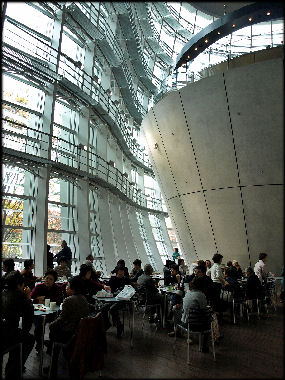
The Japan National Tourist Organization (JNTO) runs several Tourist Information Centers (TIC) in Tokyo. The main TIC office (☎ 03-3201-3331) is one floor below ground level in the Tokyo International Forum, next to Yuraku-cho Station and the Sogo department store. It is open from 9:00am to 5:00pm Monday through Friday and Saturday from 9:00am to 12:00noon. It is closed on Sunday. Its address is 1-6-6 Yurakucho, Chiyoda-ku, Tokyo 100.
Information in English and other languages is often hard to come by even in a place like Tokyo Station. The TIC office mentioned above has a wealth of information but is impossibly hard to find. There are also two tourist information offices at Narita airport. Haneda Airport has some information offices too but it took some work just to find an English-language subway map.
Websites: Go Tokyo, Official Tokyo Travel Guide gotokyo.org ; Tokyo Metropolitan Government metro.tokyo.jp ; Wikipedia Wikipedia ; Japan Guide japan-guide.com ; Japan Visitor japanvisitor.com; Tokyo Essentials tokyoessentials.com
Travel Guides: “Gateway to Tokyo” by June Kinishita and Nicholas Palevsky; “Old Tokyo: Walks in the City of the Shogun” by Sumiko Enbutsu and Charles E. Tuttle; “Tokyo Adventures” by Te Moriyama; “Tokyo Museums” by Thomas and Ellen Flannigan; “Tokyo Pink Guide” by Steven Clemens and Charles Tuttle. “Tokyo for Free” by Susan Pompian; “Time Out Guide Tokyo” ;
“Tokyo Atlas: A Bilingual Guide” (Kodansha International) has all place names in both English and Japanese and as an easy-to- read color-coded system. It even has subway station entrance numbers at commonly used stations.
Walking Tours: The Tokyo Metropolitan Government Tourist Office offers ten free walking tours with an English-speaking guide in places like Ginza, the Imperial palace, Asakusa, and Kokobunji. Some tours require people to pay about $30 to cover the museum entrance fees and subway tickets of the guides. Other are absolutely free. Websites: Tokyo City Government official site tourism.metro.tokyo.jp; Frommers Frommers.com
For Other Kinds of Information such as lists of specific hotels and restaurants, tourist agencies, currency exchanges houses, post offices, telephone offices, shops, bookstores, night clubs, sports places, theaters, swimming pools, embassies, churches, and airline agents, maps, hospitals, pharmacies, car rentals and bike and moped rentals, consult the Lonely Planet Guides and other travel guides.
Tokyo Layout and Orientation
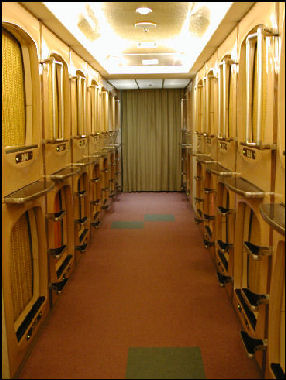
Capsule hotel Orientation: Tokyo is broken up into districts and shopping and entertainment quarters like Ginza,Shibuyu, Shinjuku, Asakusa and Harajuka, most of which can be reached by subway stations with the same name. Many places of interest are near Tokyo Station and the Imperial Palace.
Otherwise Tokyo is more than a little confusing. The map for the Tokyo subway and train system looks like a wiring diagram for Cray super computer, most small streets have no name, buildings are numbered according to age, addresses refer to a series of concentric areas and taxi drivers respond to landmarks not street numbers. Before setting out anywhere it is a good idea to have detailed directions and a good map in English and Japanese. Most stores and restaurants can fax or e-mail a good map to your hotel if you call them in advance.
Make sure you have a good subway and train map with you at all times. Most places of interest lie on or within the JR Yamanote line, a rail loop that circles central Tokyo. The major stations on the route are also the names of Tokyo's most important landmarks and districts: Ueno, Akihabara, Tokyo Station, Ginza, Shinuya, and Shinjuku.
The oldest and poorest parts of Tokyo are on the eastside of the of the Sumida River. As rule the farther up the river and the farther west you go the richer, more modern and more Westernized Tokyo becomes. Beneath Tokyo is an underground metropolis of shopping, malls, subways and subway station, restaurants and entertainment centers.
Accommodation in Tokyo
Accommodations range from the best world-class hotels (¥30,000 − ¥100,000, excluding tax and service charge, for a single room) that offer a multitude of services to more moderate ‘business’ hotels (¥8,500 − ¥15,000, excluding tax and service charge, for a single room). Traditional-style inns, Ryokan, let you experience some of the graciousness of old Japan; and your bedding is folded up and stored away during the day. Fresh tatami mats, softly sliding doors and luxurious Japanese baths (¥12,000 − ¥40,000 per person including two meals, tax and service charge are extra). All hotels are clean, safe and comfor table. Budget accommodations such as youth hostels (¥3,450 − ¥4,050 excluding meals, plus tax) are also available.
Tokyo has quite a few deluxe hotels including the Park Hyatt (used in the film of “ Lost in Translation”), a Ritz Carlton and Inter-Continental. The Tokyo Peninsula was listed as a Hot Hotel by Travel and Leisure. Many high-priced hotels are concentrated in the Akasasa District. There are many moderately-priced business hotels, hostels, and capsule hotels in Tokyo. Many are within a few blocks of well-used train and subway stations. The are a number of tourist hotels and tidy Western-style hotels in Yamanote near Shinagawa station and in the Tokyo Station area. You can also check the Ueno, Asakusa, Shinjuku Shibuya and Roppongi districts. Love Hotel hill in Shibuya has some capsule hotels. The youth hostels have curfews and cheap gaijin houses tend to be in out of the way locations. It is worth checking the Internet for deals. Make sure you select a place you can find.
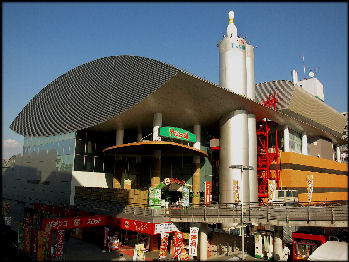
modernist station ” Hotels in Japan” from the Japan National Tourist Organization (given out at overseas tourist offices) has a good list of deluxe, luxury and standard hotels. The Lonely Planet books have good lists of cheap accommodation options. Tokyo has a hotel tax: ¥100 per head on rooms that cost under ¥15,000; and ¥200 per head on rooms that cost over ¥15,000.
Hotel Websites:Japan Hotel & Ryokan Search jnto.go.jp/ja-search; Japan Hotel Association j-hotel.or.jp/en; Japan City Hotel Association jcha.or.jp ; Japanese Inn Group japaneseinngroup.com; Tokyo Hotel Guide tokyo.hotelguide.net ; Hotels Combined hotelscombined.com ; Planet Tokyo planettokyo ; Ryokan and Minshuku Japan Ryokan & Hotel Association ryokan.or.jp; Japanese Guest Houses Japanese Guest Houses Budget Accommodation: Japan Youth Hostels (click hostels for good map and description of hostels) Japan Youth Hostels; Check Lonely Planet books
Tokyo Restaurants
People in Tokyo are known for their love of eating out and there are more than enough restaurants to satisfy them. Establishments range from 5-star quality to modest vendors in stalls around the stations. Fast food chains are also represented in force, both local and international ones. Most moderately-priced restaurants still have plastic models of what they serve in the window, and most traditional-style Japanese restaurants still specialize in one kind of cuisine. Truly fine restaurants are now plentiful and several worldrenowned restaurants have opened up branches in Tokyo, although the smaller ‘bistro’ type can be equally as delicious.
There are approximately 160,000 restaurants in Tokyo, offering a variety of Japanese foods, as well as cuisine from China, France, Italy, America, Russia, Korea, Spain, Myanmar, Thailand, India, and many other countries. Restaurants are everywhere. It is hard to find a street in the city that does not have at least one Japanese restaurant specializing in ramen noodles, tempura (deep fried shrimp, fish, and deep fried in oil), sushi (raw fish or shrimp on a lump of rice wrapped in a special kind of seaweed), sukiyaki (strips of meat eaten with raw egg) or shabu shabu (strips of meat eaten with a spicy sesame sauce).
Many coffee shops serve ‘set’ breakfasts and lunches, while standard restaurants, which serve dishes with elements of both Western and Japanese foods, have reasonably-priced luncheon ‘sets’. Department stores and malls invariably have a restaurant floor with a variety of Western, Asian and Japanese restaurants — usually toward the top — and their basement food floors and larger supermarkets have prepared foods ‘to go’.
Tokyo also has a variety of fast-food chains, both Japanese ones and American favorites as McDonald's, Wendy's, Burger King, Kentucky Fried Chicken, and Pizza Hut and numerous cafes and coffee shops. There are even Outback Steakhouse and TGI Friday's. Prices in the restaurants range from moderate to extremely expensive. One of the best ways to sample the restaurants in Tokyo is at lunchtime when a meal costs half as much when served in the evening.
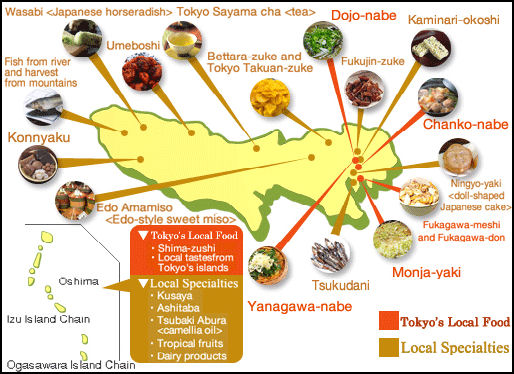
food offerings in Tokyo
Tokyo has a Hard Rock Café as well as branches of some of Paris's most famous restaurants such as L'Atelier de Joel Robuchon Roppongi Hills Restaurant. Lists of restaurants are available from the tourist offices and found in restaurant guides on sale at bookstores and newsstands. “Good Tokyo Restaurants” by Rick Kennedy and “Tokyo Restaurant Guide” by John Kennerdell are a handy resources. Robb Satterwhite's “ Tokyo Food Pages” lists 1,000 places. You can also check lists of restaurants and suggestions in local entertainment magazines, the Lonely Planet books, and other guidebooks. For information on the Michelin Guide Tokyo see below.
Restaurant and Food Areas in Tokyo
There are many good eating area in and around the Ginza District, the Hibiya shopping and amusement quarter, Tokyo Station, Shibuyu, Shinjuku, Asakusa and Roppongi. Harajuka is popular with young people. Akasaka is known for its expensive high-quality Japanese restaurants and inexpensive bars and snack shops.

Grilled meats and vegetable are available for about $1 a stick at the outdoor yakatori bars near Yurakucho Station. In the Shibuya and Shinjuku are there are guys in trucks that sell doner kebabs, sandwiches and tasty street food.
Yatai trucks offering cheap take-away item like tacos, hot dogs, doner kebabs, curry and rice, sandwiches, pastas, and fruit drinks also can be found in the boutique areas of Aoyama and Daikanyama, trendy areas like Harajuku and Shimkitazawa, business districts, including Otemachi near Tokyo Station and the Imperial Palace and residential neighborhoods such as Hiroo.
A good place to sample sushi, especially tuna, sashimi (raw fish) and dishes made with fresh fish are in the restaurants around Tsukiji fish market. There are hundreds of good noodle restaurants around Jiyugoaka station. The restaurants at the hotels tend to be overpriced. There is a large Chinatown in Yokohama with a hundreds of Chinese restaurants. Unlike their counterparts in New York or San Francisco, these restaurants tend be somewhat expensive and have fancy decors. If you want to sample the food that sumo wrestlers eat try the chankonabe at restaurants like Tomoegata, Ouchi, Yoshina, Kawasaki and Beer Station Ryoguku is Ryogoku, where many sumo wrestling stables are located. Many of these places are within walking distance of JR Ryogoku Station.
Websites: Tokyo Food Page Bento.com ; Planet Tokyo planettokyo.com
Michelin Guide to Tokyo
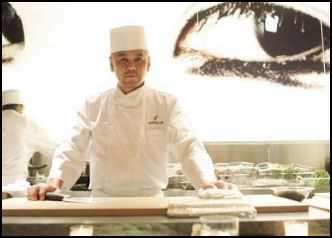
The “Michelin Guide Tokyo 2008" was the first restaurant guide produced by Michelin for an Asian city. Released at the end of 2007, it topped the bestseller list in Japan and became a popular topic of conversation, especially the designation of restaurants with Michelin stars. The guide was put together based on information collected by five undercover Michelin inspectors who sampled 1,500 of Tokyo's approximately 160,000 restaurants.
Michelin gave its top ranking of three-star to eight Tokyo restaurants' the Japanese restaurants Koju, Kanda and Hamadaya, the French restaurants Qintessence, Joel Robuchon and L'osier and sushi restaurants Sukiyabashi Jiro and Sushi Mizutani. Sukiyabashi Jiro is an unusual choice in that it is located in a basement, shares a toilet with another restaurant and has no menu. Another 25 restaurants received two stars and 117 were awarded one star.
Unlike the Michelin guides produced in Europe all 150 restaurants in the guide got stars, for a staggering total of 191 stars. This is by far the most stars given to a city. Paris second with 94 stars and New York is third with 54. A spokesman for Michelin said, "There was a lot of surprises about the high quality of Japanese restaurants during one year of research. It was proved that Tokyo is one of the world's shining gastronomic cities."
In the second edition of the Michelin guide for Tokyo (“Michelin Guide Tokyo 2009"), nine restaurants were awarded three stars, 36 received two stars and 128 got one star for a total of 173 restaurants receiving a total of 227 stars. Of the nine three-star restaurant, eight were listed before. The new addition was Ishikawa, a Japanese restaurant in Shinjuku Ward.
Transportation in Tokyo
There are 43,000 taxis on the streets of Tokyo. There are also lots of buses running on confusing routes. The train and subway system is good but is a bit complicated because different train and subway companies operate different lines and sometimes you have to change from a line operated by one company to a line operated by another company and you may need a different ticket for each line. Sightseeing tours of the city by bus have regular scheduled departures. The bus, called Hato (pigeon), visits famous spots such as the Tokyo Tower, Ginza, and Asakusa. For more information see the "Getting Around Within Cities" in the Tourist Information section. factsanddetails.com
According to ASIRT: “Road signs may be misleading, and intersections may be confusing. Roads are extremely congested during rush hour. It may take 2 hours to make a 20-mile trip in the Tokyo area. Sidewalks may be absent. Lines painted on the side of the road sometimes mark very narrow footpaths. Bus and taxi travel are often slow due to congestion. Long-distance buses run between Tokyo and other major cities. [Source: Association for Safe International Road Travel (ASIRT), 2007: PDF: asirt.org]
Tokyo has two airports: the New Tokyo International Airport in Narita (the Narita Airport) and the Haneda Airport. The Narita Airport handles international flights, and the Haneda Airport handles domestic and international flights. The Narita Airport is 65 kilometers (40 miles) from Tokyo. There are many transportation options to Tokyo: Airport limousine buses are most often used. Regular bus service is available to the Tokyo City Air Terminal in central Tokyo and to Tokyo and Shinjuku Stations. Less frequent bus service runs from the airport to the major hotels in Tokyo. Trains depart regularly from the Narita Airport Station and provide the most rapid service to Tokyo.
Taxis in Tokyo are plentiful, spot bright lights on their roofs for easy identification and display a red light in the front window when vacant (green when not). Although it is usually possible to hail one by raising an arm and flagging it down, in some places and at certain times it is only possible to catch one at a taxi stand. The passenger door is operated by remote control by the driver. As the drivers rarely understand English it is best to have a map and directions/address in Japanese. Fares start at ¥730 (for the first 1,052 meters or 0.65 miles) and rise in ¥80 increments (every 237meters/0.14miles or every 1 min. 30 sec. waiting time). 20% surcharge between 10:00 p.m. and 5:00 a.m.
German-made tricycle cabs, known as velotaxis, are becoming increasing popular in Tokyo. Introduced in May 2002, and operating mostly in fashionable districts such as Ometesando and Minamiaoyama, they have a roof, three wheels and room for two passengers and are bright yellow or blue in color. They travel at a maximum speed of around 15mph and have a small electric motor that kicks in to offer some help on steep inclines. The flagfall fare is ¥300 for the first 500 meters and ¥50 for each additional 100 meters. Over longer distances the cost more than normal taxis.
Websites: Tokyo City Government official site kotsu.metro.tokyo.jp Tokyo Metro tokyometro.jp ; Japan Guide japan-guide.com ; Wikipedia Wikipedia
Subways and Trains in Tokyo
Train and subway lines form a vast interlocking network that covers most of the city. Nearly 15 million people pass though Tokyo's subway system every day. Twenty million pass through the metropolitan area's subway an train system. The subway system operates between 5:00am and 12:00 midnight. During rush hour some subways stations still employ people to push and shove the passengers inside. The system is a bit complicated because different train and subway companies operate different lines and sometimes you have to change from a line operated by one company to a line operated by another company and you may need a different ticket for each line.
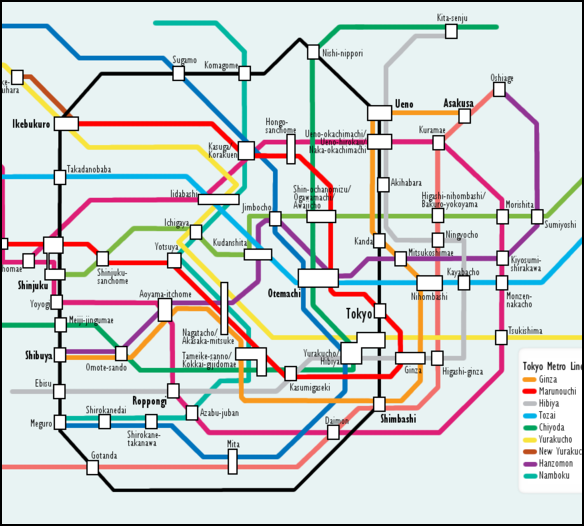
Tokyo subway map
The subway system in Tokyo extends more than 240 kilometers (150 miles). Color-coded, Tokyo's subways and trains are fast, efficient, frequent, safe and clean but are best avoided during rush hours. Train exits are indicated by direction; East, West, North, South and Central, while the multiple subway exits are letter/number marked. Of the 12 subway lines in Tokyo, eight are TRTA (Teito Rapid Transit Authority) lines and four are TOEI lines.
The Japan Rail Information Center at Tokyo Station and Shinjuku Station provides information on train services. Call 03 3423 0111 for information in English. Subway and Train Maps: Greater Tokyo Trains and Subways Tokyo Trains ; Tokyo Metro tokyometro.jp ; Joho Maps johomaps.com; Urban Rail urbanrail.net Tokyo Tram Map: Urban Rail urbanrail.net
Subway and Train Tickets and Passes in Tokyo
There are also numerous train lines. The fares are generally based on distance traveled. The lowest adult subway fare for a single ride in Tokyo is ¥160. Medium distance fares are usually ¥190, ¥230, ¥270 and ¥300. When you do not know the fare to your destination station, buy the lowest one from the automatic ticket vending machine and make up the difference at the other end. Locals tend to use Suica and Pasmo Prepaid IC cards for travel on JR, subways, buses and private railways in almost all areas in Japan. Special one-day passes are available.
Useful passes: 1) N'EX TOKYO Round Trip Ticket : 4,000 yen Special discount round ticket for overseas visitors when traveling from Narita Airport to major stations in the Tokyo area. Only available at Narita Airport (JR EAST Travel Service Center or JR Ticket Office). jreast.co.jp/e/pass ; 2) Tokyo Metropolitan District Pass (Tokunai Pass): 750 yen Allows unlimited rides on JR East trains within the Tokyo area. 3) Tokyo 1-day Ticket : 1,590 yen Allows unlimited one-day use on all Tokyo Metro lines, Toei subway, buses, trams as well as JR lines within the Tokyo area. 4) Tokyo Metro One-day Open Tickets : 600 yen tokyometro.jp/en 5) Tokyo Subway Ticket (24-hour: 800yen,48-hour:1,200yen, 72-hour:1,500yen) tokyometro.jp/en; 6) Toei One-day Economy Pass: 700 yen : Allows unlimited one-day use on all Toei Metro lines and buses. 7) Yurikamome One-day Pass: 820 yen
PASMO is a convenient prepaid transportation card that contains an integrated-circuit (IC) chip, allowing the user to enter the subway by simply placing the card over a PASMO card reader located on the fare gates. The card is rechargeable and can be used over and over. It can also be used for other railway and bus operators nationwide where interoperability is offered. In addition to using your charged PASMO card to ride the subway or buses, you can use it to pay for items purchased at stores and vending machines. It can also be used for member shops of railways and buses nationwide where interoperability is offered. Price denominations (Initial purchase) at ticket vending machines: 1,000 yen, 2,000 yen, 3,000 yen, 4,000 yen, 5,000 yen or 10,000 yen; At station offices and commuter pass offices: From 1,000 yen up to 20,000 yen in 1,000 yen units
Tokyo Metro 24-hour Ticket allows unlimited rides on Tokyo Metro for 24 hours from first use. Tickets can be bought in advance or on the day. Tickets can be bought at ticket machines at Tokyo Metro stations and Tokyo Metro Commuter Pass ticket offices (except Nakano, Nishi-funabashi and Shibuya stations). Price: Adult: 600 yen, Child: 300 yen
Common One-day Ticket for Tokyo Metro & Toei Subway is valid for one day of unlimited rides on all Tokyo Metro and Toei Subway lines. Tickets can be bought at ticket machines at Tokyo Metro stations and Toei Subway stations and Tokyo Metro: Tokyo Metro Commuter Pass ticket offices. Price: Adult: 900 yen, Child: 450 yen
Tokyo Combination Ticket allows unlimited rides on Tokyo Metro, Toei Subway, Toei Streetcar (Toden), Toei Bus (except for buses with fixed seats, etc.), all sections of Nippori-Toneri Liner as well as all JR lines within the Tokyo metropolitan area for one day as stated on the ticket. Tickets can be bought at Ticket machines at most but not all Tokyo Metro stations and Toei Subway stations and the JR EAST Travel Service Center. Price Adult: 1,600 yen, Child: 800 yen
Tokyo Metro Student 24-hour Ticket can be used by junior high school, high school and vocational school students, school staff and tour conductors. Tickets can be bought at JTB, Kinki Nippon Tourist, Nippon Travel Agency, Tobu Top Tours, Nishitetsu Travel, JR Hokkaido, JR Kyushu, JR Tokai Tours, Hankyu Travel, Meitetsu World Travel offices worldwide handling educational tours. Price: 300 yen
Tokyo Station
Tokyo Station is the main long-distance train station. Located in the Marunouchi business district, it is the hub for most long distance rail service and shinkansen (bullet trains) to Kyoto, Osaka, Nagoya, Hiroshima and Kyushu in the south and Nagano, Yamagata, Niigata and Akita prefectures in the north. It is also the arrival point of long distance night buses from other cities in Japan. Tokyo Station has 28 platforms. Including the Shinkansen 3,900 trains with 900,000 passengers pass through the station every day.
Tokyo Station is a good starting point for sightseeing. Built in 1926, it is a mammoth five-story complex, housing department stores, restaurants and souvenir shops as well as ticket offices and train platforms. About 1.8 million people and 4,000 trains pass through Tokyo Station every day.
The two underground malls — Yaesu Chikagai and Tokyo Eki Meitengal — and Chu-dori Thoroughfare are good for shopping. The Western-style red-brick facade of the station facing the Marunouchi side is a traditional landmark, part of which is utilized as a hotel.
Restoration of the Marunouchi-side building to its original began in early 2006. Over a five year period the original design by architect Kingo Tatsuno (1854-1919), which includes a third floor and cupola domes destroyed in World War II, will be reconstructed. When the reconstruction is finished in 2011 the building will look it did in 1914.
Websites: JR East Tokyo Station Map jreast.co.jp ; Wikipedia Wikipedia ; Japan National Tourism Organization JNTO

Renovated Tokyo Station
JR Tokyo Station Marunouchi Building reopened in 2012 after an extensive renovation. After it reopened, the Yomiuri Shimbun reported: “JR Tokyo Station has now recovered its century-old appearance with the return of the curved ceilings of its domes and a third floor that was destroyed by U.S. bombing in 1945. The domed ceilings located at the north and south ends of the station building are the main feature of the newly restored facility. A luxurious relief inside depicting flowers and creatures of the Oriental zodiac make the building look just like it did in 1914 when it was completed. [Source: Koki Kataoka, Yomiuri Shimbun, October 2012]
“Through the windows of the hotel’s dome-side suites, guests can enjoy the decorative ceilings and gaze at passengers walking along the station floor below. At a restaurant on the second floor, patrons can enjoy the sight of trains running just beyond the window. The restaurant must be a gem for railway enthusiasts. Right next to the station’s North Exit stands Tokyo Station Gallery. Century-old original bricks and steel frames were used to build part of its interior. Some of its interior decorations include charred wooden bricks from the 1945 air raid, effectively turning the gallery into a work of art.
Tokyo Station Hotel in the building, is performing well. Its occupancy rate in October is more than 70 percent and its restaurants are fully booked. With more people visiting the station, cash registers at nearby commercial facilities also have been ringing. "Reflecting the increase of tourists, sales have been even better at restaurants than in shops," said a public relations official at Mitsubishi Estate Co., which runs the two buildings. According to Hato Bus Co., which operates tour buses from near Tokyo Station, the number of customers who roll up and join a tour on that day is increasing. A Hato Bus official said many people go on a Tokyo sightseeing tour after visiting the station. Expectations are growing that the economic effects generated by the renovated station building will spread further. [Source: So Sasaki, Yomiuri Shimbun, October 24, 2012]
Image Sources: 1) Ray Kinnane 2) JNTO 3) Strange and Funny Japan blog 4) Ray Kinnane 5) Wikipedia
Text Sources: JNTO (Japan National Tourist Organization), Japan.org, Japan News, Japan Times, Yomiuri Shimbun, UNESCO, Lonely Planet guides, New York Times, Washington Post, Los Angeles Times, National Geographic, The New Yorker, Bloomberg, Reuters, Associated Press, AFP, Compton's Encyclopedia and various books and other publications.
Updated in July 2020
